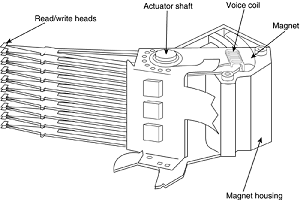Hardisk Read/Write Heads
A hard disk drive usually has one read/write head for each platter surface (meaning that each platter has two sets of read/write heads—one for the top side and one for the bottom side). These heads are connected, or ganged, on a single movement mechanism. The heads, therefore, move across the platters in unison.
Mechanically, read/write heads are simple. Each head is on an actuator arm that is spring-loaded to force the head into contact with a platter. Few people realize that each platter actually is "squeezed" by the heads above and below it.
If you could open a drive safely and lift the top head with your finger, the head would snap back down into the platter when you released it. If you could pull down on one of the heads below a platter, the spring tension would cause it to snap back up into the platter when you released it.
Figure below shows a typical hard disk head-actuator assembly from a voice coil drive.

When the drive is at rest, the heads are forced into direct contact with the platters by spring tension, but when the drive is spinning at full speed, air pressure develops below the heads and lifts them off the surface of the platter.
On a drive spinning at full speed, the distance between the heads and the platter can be anywhere from 0.5 µ-inches to 5 µ-inches or more in a modern drive.
In the early 1960s, hard disk drive recording heads operated at floating heights as large as 200 µ-inches–300 µ-inches; today's drive heads are designed to float as low as 10nm (nanometers) or 0.4 µ-inches above the surface of the disk.
To support higher densities in future drives, the physical separation between the head and disk is expected to drop even further, such that on some drives there will even be contact with the platter surface. New media and head designs will be required to make full or partial contact recording possible.
To ensure the cleanliness of the interior of the drive, the HDA is assembled in a class-100 or better clean room. This specification means that a cubic foot of air can't contain more than 100 particles that measure up to 0.5 microns (19.7 µ-inches). A single person breathing while standing motionless spews out 500 such particles in a single minute!
These rooms contain special air-filtration systems that continuously evacuate and refresh the air. A drive's HDA should not be opened unless it is inside such a room. Although maintaining a clean-room environment might seem to be expensive, many companies manufacture tabletop or bench-size clean rooms that sell for only a few thousand dollars.
Some of these devices operate like a glove box; the operator first inserts the drive and any tools required, closes the box, and then turns on the filtration system. Inside the box, a clean-room environment is maintained, and a technician can use the built-in gloves to work on the drive.
In other clean-room variations, the operator stands at a bench where a forced-air curtain maintains a clean environment on the bench top. The technician can walk in and out of the clean-room field by walking through the air curtain.
This air curtain is very similar to the curtain of air used in some stores and warehouses to prevent heat from escaping in the winter while leaving a passage wide open.
Because the clean environment is expensive to produce, few companies except those that manufacture the drives are properly equipped to service hard disk drives.
Read/Write Head Designs
As disk drive technology has evolved, so has the design of the read/write head. The earliest heads were simple iron cores with coil windings (electromagnets). By today's standards, the original head designs were enormous in physical size and operated at very low recording densities.
Over the years, head designs have evolved from the first simple ferrite core designs into the magneto-resistive and giant magneto-resistive types available today.